|
|
|||
|
(Back to Preceding Week; on to Next Week) |
|
Blue-throated
|
A few spaces are still available for our 2010 midwinter HUMMINGBIRD |
Canivet's
|
|
Join us for the |
|
|
COLORFUL VAGRANT HUMMINGBIRD:
When Martha and Jim Evans of Moore SC noticed action at their long-vacant hummingbird feeder this week, they were a bit surprised. Ruby-throated Hummingbirds visiting all summer had disappeared by late October, and nothing else had been paying any attention to the sugar water mixture. That all changed on 6 December 2009 when a very different hummer showed up to dine. Rusty on its back and head, the little visitor left little doubt in Martha's mind she and Jim were hosting a vagrant hummingbird far away from its expected winter habitat, and she was equally confident the bird was an adult male Rufous Hummingbird, Selasphorus rufus. We rose at 4:30 a.m. on 11 December and departed for Moore half an hour later. In our experience, it's best to try trapping a winter vagrant very early in the morning--preferably at or just after sunrise when the hungry hummer is making its first feeder run of the day. This procedure has worked quite well for us and we've missed our quarry only a couple of times--even though the technique has cost us many hours of midwinter sleep. We arrived at the Evans residence right at 6:30 a.m. and after meeting Martha and Jim went about hanging our portable trap on their back deck where the unusual hummingbird had been seen. We placed a feeder in the trap, set the mechanism, and retired to the kitchen where we joined Martha and Jim in pre-dawn darkness, sharing hummingbird stories and anxiously waiting for the object of our affection to show up.
All text & photos © Hilton Pond Center At about 6:50 a.m. something buzzed past the feeder and both Martha and Jim said it was the hummingbird. We didn't get as good a look until a second fly-by at 7:10 a.m.; by then we were confident something other than a chickadee or titmouse was scoping out the trap. At precisely 7:22 a.m. the bird we wanted finally entered the trap and fed for a moment before we flicked a switch that caused the trapdoor to slide shut--after which Martha and Jim expressed considerable excitement over our capture of their wayward hummingbird. Even from inside the kitchen we could see the bird's solid rusty back (above), so we were certain it was indeed a Rufous Hummingbird.
All text & photos © Hilton Pond Center We, too, were excited, in part because it was our first vagrant hummer of the winter season but especially because it's so seldom we get to handle an adult male Rufous. In fact, this was only our second adult male of its species in the 18 years we've been banding winter vagrants, the last one being long, long ago in 1994! We've banded 64 Rufous Hummingbird vagrants since 1991; the overwhelming majority of them (47) have been females, with just 15 immature males.
All text & photos © Hilton Pond Center It certainly seems adult male Rufous Hummingbirds are less likely to wander than other age/sex classes. The species breeds in southern Alaska, western Canada, and the northwestern U.S. and typically overwinters in central Mexico, but for some unknown reason occasional individuals show up in eastern states--usually in late fall or early winter. Although South Carolina sightings of Rufous Hummingbirds occurred--albeit very rarely--as far back as the early 1900s, about 20 years ago reports of Rufous and several other western hummer species increased dramatically. No one knows for sure the cause; there are probably a number of environmental factors involved.
All text & photos © Hilton Pond Center In any case, at 7:22 a.m. on 11 December we had a Rufous Hummingbird in a trap; we carefully removed it, brought it into the Evans' kitchen, and placed the bird in a paper tube for safekeeping. While Jim looked on and Martha took photos, we showed them how we measured the hummer's tail, wing chord, culmen, and mass, and how we fabricated the tiny numbered aluminum band before placing it on the bird's left leg.
All text & photos © Hilton Pond Center With that we took down the trap, re-hung the hummingbird feeder, and packed up our banding gear; we also set up our camera on a tripod with a 400mm telephoto lens aiming through the patio door glass at the feeder about 20 feet away. As Martha treated us to homemade coffee cake and some hot herbal tea with honey, we watched the feeder in the hope her Rufous would show up again. It wasn't long before this supposedly "out-of-range" and now-banded vagrant returned to the feeder, sat down in the still-dim morning light (above), and spent a few minutes lapping up sugar water--none the worse for wear and ready to make winter much more interesting for the Evans family. We thank Martha and Jim for their hospitality and for allowing us to visit and work with their colorful avian visitor.
All text & photos © Hilton Pond Center Handling the Evans' Rufous Hummingbird was a real treat. Although we've had very little experience with adult males of this species, we did notice something that surprised us about the bird's wings. When we spread the right one to look for molt (above), it looked to us like eight of ten primary feathers were new, with the two outermost feathers--the ones on the lead edge of the wing--looked older, more faded and worn. We're not sure when the wing molt cycle typically begins in Rufous Hummingbirds, but if we're reading the wing correctly late November or early December seems a little early. In any case, it appears this particular bird has a head start on a new set of flight feathers that will serve him well when he decides to head back toward his breeding grounds--3,000 miles away along the Pacific Coast of North America. All text & photos © Hilton Pond Center
Comments or questions about this week's installment?
Thanks to the following fine folks for recent gifts in support of Hilton Pond Center for Piedmont Natural History and/or Operation RubyThroat: The Hummingbird Project. Your tax-deductible contributions allow us to continue writing, photographing, and sharing "This Week at Hilton Pond." (Please see Support if you'd like to make a gift of your own. You can also contribute by ordering an Operation RubyThroat T-shirt.)
Hummingbird Image © Marie Baumann "This Week at Hilton Pond" is written & photographed You may wish to consult our Index of all nature topics covered since February 2000. You can also use our on-line Hilton Pond Search Engine at the bottom of this page. For a free, non-fattening, on-line subscription to |
|
Make direct donations on-line via
Network for Good: |
|
|
Use your PayPal account
to make direct donations: |
|
|
If you like to shop on-line, you please become a member of iGive, through which more than 750 on-line stores from Barnes & Noble to Lands' End will donate a percentage of your purchase price in support of Hilton Pond Center and Operation RubyThroat. For every new member who signs up and makes an on-line purchase iGive will donate an ADDITIONAL $5 to the Center. Please sign up by going to the iGive Web site; more than 200 members have signed up to help. It's a painless, important way for YOU to support our on-going work in conservation, education, and research. |
|
|
SPECIES BANDED THIS WEEK: * = New species for 2009 WEEKLY BANDING TOTAL 4 species 15 individuals 2009 BANDING TOTAL 62 species (28-year avg. = 68.9) 1,718 individuals (avg. = 1,914.3) 28-YEAR BANDING GRAND TOTAL (since 28 June 1982, during which time 170 species have been observed on or over the property) 124 species 53,600 individuals NOTABLE RECAPTURES THIS WEEK (with original banding date, sex, and current age) White-throated Sparrow (3)
NOW is the time to report your RTHU fall departure dates from the U.S. & Canada, and fall arrival dates for Mexico & Central America. Please participate.
|
OTHER NATURE NOTES OF INTEREST --Talk about rain! The first week of the month was particularly wet, with several days of precipitation topped by more than an inch overnight on 7-8 Dec. (Hilton Pond Center's rain gauge has registered 4.6" from Thanksgiving Day to 8 Dec.) Rainfall and runoff combined to bring Hilton Pond to overflowing for the first time since last winter. It's always amazing to watch the water level rise several inches in just a few hours, especially because an increase in depth also adds noticeably to the impoundment's ever-changing surface area. --Heavy wind, all that rain, and another bout of respiratory crud interfered with banding during the period and limited us to just 15 birds (above left). Among these was our 38th Mourning Dove of 2009. This bird eclipsed the old record for his species, set 'way back in 1988. --To read our discussion of factors we think might have caused an increase in sightings of winter vagrant hummingbirds in recent years, please see Vagrant & Winter Hummingbird Banding. Included is a list of all vagrants we've banded since 1991--two have been right here at Hilton Pond Center and several have been encountered again--plus hints on how to care for winter hummers.
|
|
(Back to Preceding Week; on to Next Week) Up to Top of Page Back to This Week at Hilton Pond Center Current Weather Conditions at Hilton Pond Center |
 You can also post questions for The Piedmont Naturalist |
Join the |
Search Engine for |
|
|
Cable Internet

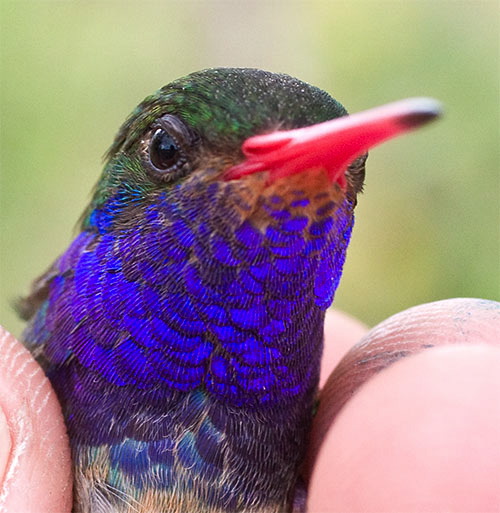
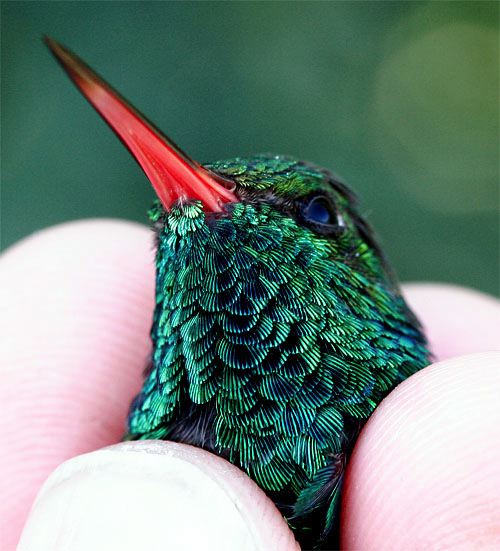
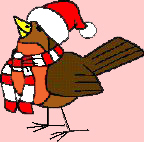
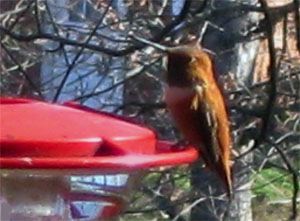 Martha posted her sighting to a gardening listserv and was advised pretty quickly to contact us at Hilton Pond Center, which she did via phone and e-mail on 7 December. It sounded from her description that Martha had made a correct identification, so we talked about the possibility of our making the 90-minute trip from Hilton Pond to the Evans home in Moore, just south of Spartanburg about 70 miles to our west down I-85. We were a bit under the weather and recovering from a ten-day wrestling match with a respiratory infection but hoped to get over to Moore within the week. However, when Martha's daughter, Ann Guyer, e-mailed us a photo of the vagrant hummer on 10 Dec, the bird's brightly colored plumage had a near-miraculous therapeutic effect and we immediately called Martha with our intent to be at her place early the next day.
Martha posted her sighting to a gardening listserv and was advised pretty quickly to contact us at Hilton Pond Center, which she did via phone and e-mail on 7 December. It sounded from her description that Martha had made a correct identification, so we talked about the possibility of our making the 90-minute trip from Hilton Pond to the Evans home in Moore, just south of Spartanburg about 70 miles to our west down I-85. We were a bit under the weather and recovering from a ten-day wrestling match with a respiratory infection but hoped to get over to Moore within the week. However, when Martha's daughter, Ann Guyer, e-mailed us a photo of the vagrant hummer on 10 Dec, the bird's brightly colored plumage had a near-miraculous therapeutic effect and we immediately called Martha with our intent to be at her place early the next day.


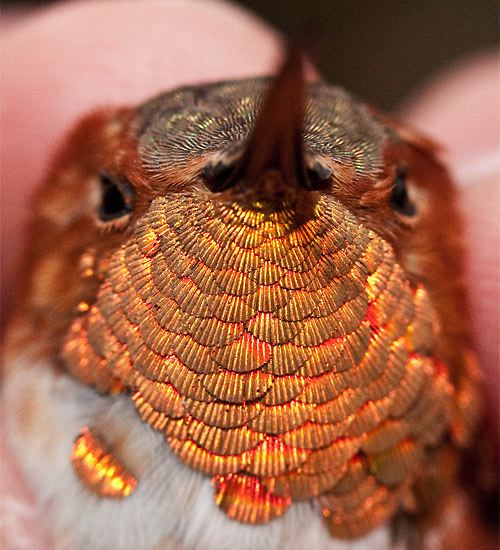
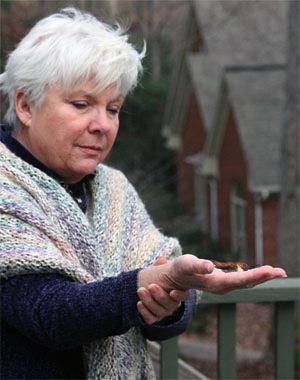 The whole process took less than ten minutes--including the time we took to insert the hummer's bill into a feeder port and watch it drink without any hesitation. We also made note of the bird's brilliant metallic gorget (above)--much more orange than the deep red of an adult male Ruby-throated Hummingbird. (We wondered whether the irregular lower edge of the gorget on the Rufous was an indicator this bird was a relatively young adult.) When measurements and banding were complete, we took the bird back onto the deck for photos--including a shot of Martha (above left) holding her vagrant Rufous Hummingbird just before it exploded from her hand and made a beeline across the yard.
The whole process took less than ten minutes--including the time we took to insert the hummer's bill into a feeder port and watch it drink without any hesitation. We also made note of the bird's brilliant metallic gorget (above)--much more orange than the deep red of an adult male Ruby-throated Hummingbird. (We wondered whether the irregular lower edge of the gorget on the Rufous was an indicator this bird was a relatively young adult.) When measurements and banding were complete, we took the bird back onto the deck for photos--including a shot of Martha (above left) holding her vagrant Rufous Hummingbird just before it exploded from her hand and made a beeline across the yard.
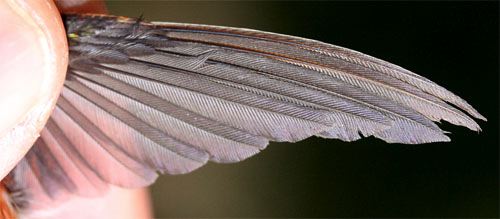
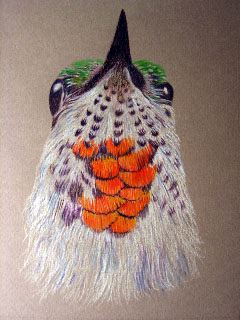



 Oct 15 to Mar 15:
Oct 15 to Mar 15: